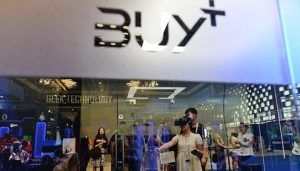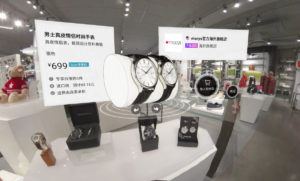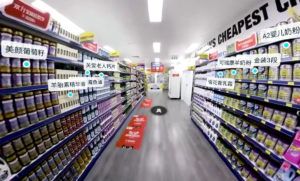AR/VR‘s Today and Future in Alibaba: In Retail and Beyond

What can this internet conglomerate do and how can it thrive in AR/VR?
Alibaba, one of China’s biggest internet conglomerate, has been actively pursuing AR/VR by integrating VR shopping into its e-commerce platform, launching an incubator for AR/VR content and hardware, as well as investing in relatively mature hardware and software companies.
Alibaba’s major activates in pursuing AR/VR:
| Time | Activity |
| February, 2016 | Led Series C investment in Magic Leap with a total amount of funding of $794 million USD) |
| March, 2016 | Kicked off Project Buy+ to build the biggest 3D database for merchandises |
| July, 2016 | Showcased Buy+ demo of HTC Vive + 3D merchandise shopping experience |
| November, 2016 | Invested $15 million USD in Infinity AR, an Israel-based AR engine and solution startup |
| November, 2016 | Launched Buy+ on Taobao APP with a Cardboard + 3D merchandise model |
| January, 2017 | Invested $6 million USD in Lumus in the Israel-based AR optical element and headset startup’s Series C funding |
| January, 2017 | Invested over $10 million USD in WayRay, a Swiss-based embedded automobile AR technology company |
(Source: http://www.geekpark.net/topics/217834)
Current Value Creation
Alibaba is currently focusing on experimenting VR technology applications at its e-commerce marketplace. The showcase it presented in July 2016 allowed consumers to experience a journey of shopping in stores of Target, Macy’s, Costco, and another four oversea retailers.
Consumers need a HTC Vive headset to try out the demo.
Consumers start a shopping journey by selecting one of the seven photos hanging on the wall.
Each of the photos represents one of the seven oversea retailers.
Consumers will be picked up by a limo if a U.S. retailer is chosen.
Consumers can check certain merchandises and turn them horizontally within 180 degrees.
Consumers are only allowed to go one pre-designed route when browsing.
Consumers can only check out selected merchandises in the old online shopping manner
– going through shopping cart, not by interacting with cashiers.
(Picture Credit: 36Kr)
Current value creation model of this VR application is fairly straightforward. On the consumer end, the enhanced online shopping experience is fresh, interesting and presumably more enjoyable. On the retailer end, this use case helps them better exhibit merchandises and therefore, hopefully, boost sales. To lower adoption barrier for consumers, Buy+ on Taobao APP chose Cardboard rather than HTC Vive as compatible headset. And Alibaba has been working on developing dev kits to help retailers establish Buy+ 3D profile for their merchandises.
Current Value Capture
Alibaba’s capability to monetize on Buy+ is constrained in its existing marketplace model – charging commission for successful transactions, given that Buy+ initiative and the whole VR sector behind are still at a nascent stage. With limited consumer and retailer adoption, Buy+ currently is more of a marketing vehicle for both Alibaba and its retail partners to shape their brand perceptions, and a long bet of this e-commerce giant to stay relevant in the potentially coming future AR/VR world.
Recommendations
Given the asset-light model and current impressive profitability of Alibaba’s core business, access to capital is not a problem for the company. Thus it is in a good position to invest in AR/VR. Before the technology and ecosystem mature, price of hardware and software becomes affordable, and user case gets proven, Alibaba can patiently keep on its current VC-like investment and Buy+ experiment. Once the tipping point comes, the established advantage in AR/VR of this internet conglomerate can be expected to play out broadly.
New Normal of Omni-Channel Strategy in Retail Industry
AR/VR is likely to accelerate or even force the whole retail industry to transit to omni-channel operation, as some of the values that are currently perceived as uniquely provided by brick-and-mortar stores, such as seeing is believing, and immersive and interactive experience, will further diminish.
As the tech savvy player, Alibaba is capable of creating and capturing more value by helping brick-and-mortar and even e-commerce retailers to integrate offline and online businesses. In addition, AR/VR can go hand-in-hand with big data at Alibaba’s platform to personalize consumer’s shopping experience, and improve merchant’s overall operation efficiency, especially in areas like marketing and procurement.
Disruption in Video and Live Event Entertainment
Alibaba Pictures is a subsidiary of Alibaba Group that is separately listed in Hongkong and Singapore stock markets. The company produces and distributes theater movies and TV dramas, and invests in overseas film productions (such as Ninja Turtles 2, Star Trek 3, Mission Impossible 5). Furthermore, Alibaba Pictures formed a strategic partnership with China’s leading online video streaming platform, Youku/Tudou, behind Alibaba Group’s financial investment. As the applications of AR/VR grow mature in video entertainment sector, Alibaba stands a big chance to disrupt industry landscape in the lucrative China movie market by bring traffics from movie theaters to online video streaming websites with an enhanced watching experience. Leveraging these same assets, Alibaba can also easily expand to live event business.









Thanks for the post, Yao!
I find VR particularly interesting in the e-commerce context, given its potential to bridge the gap between brick & mortar and online experiences. Although Buy+ currently serves primarily as a marketing tool for Alibaba / its retail partners to shape their brand perceptions, I’d be curious to see whether integration of AR actually allows retailers to onboard new customers (ie those putting high value on “in-person browsing” side of shopping / “experiencing” the products) and/or reduces trust issues when it comes to product characteristics and quality.
Largest share of Alibaba’s GMV comes from fashion vertical, where more detailed “look” into the product could help customers choose the right size and reduce returns (& subsequently costs for Alibaba / merchants). Also, it will be interesting to see if VR can help our mental transition to purchasing groceries online – arguably one of the verticals where (in-person) browsing of products is currently seen very important by customers and the category is fairly underdeveloped in the e-commerce context.
Great post Yao! I think you are spot on in predicting the impact that VR can have in retail. VR can help in overcoming the “window-shopping” that consumers do as part of which they will go to a retail store to check out a product but then order it online on Amazon. When we saw the migration of retail from brick and mortar to online, we saw that regional monopolies emerged – like Amazon in US, Alibaba in China etc. Do you think the move from online to VR can lead to intense competition between these regional monopolies?
Yao – loved the post. I am a big believer in how VR can disrupt retail. I wonder if Amazon is gearing up for it. They haven’t disclosed anything but recently media picked up on a VR related job posting on Amazon Careers page:
https://d3.harvard.edu/platform-digit/submission/amazon-behind-on-the-vr-chasm/#_ftn2
No one knows if it is for retail or video or something else. But something is definitely coming. (Shameless plug: refer to my blogpost related to this: https://d3.harvard.edu/platform-digit/submission/amazon-behind-on-the-vr-chasm/)
Within retail, do you think there are specific verticals which can benefit more from VR than others? For example, scanning through aisles and aisles of items might be a very annoying and customer-unfriendly process. A customer might go to Amazon.com instead. But furniture can really benefit from VR. What do you think?